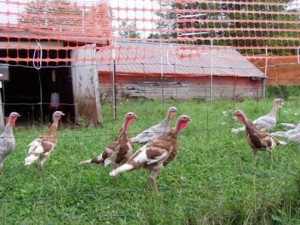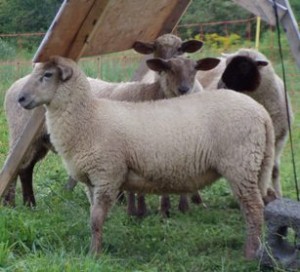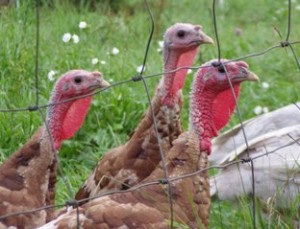 That’s really not quite the correct turn of phrase because we are basically moving most of the animals around in movable pens to new grass every day, but it will do.
That’s really not quite the correct turn of phrase because we are basically moving most of the animals around in movable pens to new grass every day, but it will do.
As you may recall, the chicks and turkey poults arrived, aged three days, in the middle of May. So, at this point, they are 10 weeks old. The really interesting thing is that although they were just about the same size, within days, the poults took off and haven’t stopped growing since. They have a long way to go before they are …ahem…oven ready. But they are certainly growing. We have two heritage breeds: Bourbon Red and Slate Blue. We could have gone with the standard ‘butterball type’ which is referred to as ‘Broad-breasted White’ but since we’d never raised turkeys before, we decided to give a couple of heritage breeds a try. So far, I can tell you this: If you can keep them alive for the first couple of weeks – they are tough as nails. Now, because of what we estimated to be their later size, we decided that making them some sort of version of ‘chicken tractor’ was just not going to work for us. We also wanted to give them a bit of shelter and fenced in a large area around a small shed that we already had. We also attached pvc pipes to extend the fence posts and ran snow fencing around that (I think we should buy stock in whatever company produces ‘zip ties’ because we seem to have gone through an amazing number of those this year). And, to be blunt, we hampered their amazing flying abilities by shortening a couple of the flight feathers in their wings. Literally, it would be like cutting your hair, but it unbalances them enough that they can’t get up enough speed or lift to get over the snow fencing.
Again, a small reminder: Like the chickens, we have to supplement what they find on the ground or in eating the plants with a mash. With turkeys, you need more protein than you do with chickens but basically we are talking about the same sort of feed ration made up of grains.
The sheep (see our suspicious friend at the top), on the other hand, because they are ruminants, are being moved around and fed fresh pasture every couple of days. And as you can see from the photographs, they are really doing well. This photo from the side gives you a good image of the digestive capacity of ruminants – see that abdominal area?  That’s all the most sophisticated digestive system you can possibly imagine, used to convert cellulose into protein. For all the attention paid to feed rations for sheep, goats, and cows, frankly, they already have the wherewithal to produce everything they need with their four stomach system, complemented by their cud chewing. It’s an amazing system and as you can see from what these lambs look like at this point, with absolutely no effort on our parts – although we did put out a bit of clover seed last year, what is available to them is everything from golden rod to Queen Ann’s Lace and very very rough grasses. The ‘dressed weight’ on sheep is about 35%-40% (so, in other words, if you start out with a 100 pound sheep, you will get between 35 and 40 pounds of cut and wrapped lamb BACK), so we are planning to keep the lambs on grass for as long as it lasts. We have had a lot of good rain over the past two weeks so the pastures have come back nicely and it looks as if we will be able to take the lambs through into the fall without having to buy hay for them.
That’s all the most sophisticated digestive system you can possibly imagine, used to convert cellulose into protein. For all the attention paid to feed rations for sheep, goats, and cows, frankly, they already have the wherewithal to produce everything they need with their four stomach system, complemented by their cud chewing. It’s an amazing system and as you can see from what these lambs look like at this point, with absolutely no effort on our parts – although we did put out a bit of clover seed last year, what is available to them is everything from golden rod to Queen Ann’s Lace and very very rough grasses. The ‘dressed weight’ on sheep is about 35%-40% (so, in other words, if you start out with a 100 pound sheep, you will get between 35 and 40 pounds of cut and wrapped lamb BACK), so we are planning to keep the lambs on grass for as long as it lasts. We have had a lot of good rain over the past two weeks so the pastures have come back nicely and it looks as if we will be able to take the lambs through into the fall without having to buy hay for them.
One plan we do have is that once the turkeys and lambs have, ‘gone down the road’, and the chickens have been separated out between the hens who will stay with us for eggs and the roosters who…won’t, the pastures will be empty again and we will find a way to harrow up the pastures and put down lime and perhaps more pasture grass seed this fall before the snow flies. One of the problems we have with this pasture is that it is so ‘sour’ (an acidic pH) that we don’t have the sorts of plants that we want to have. So putting down some limestone to bring the pH closer to neutral is really important and opening up the pasture soil to that and the seeds before the snow starts to fall and ground freezes will give us a good start for next spring. And yes, they really do go ‘gobble’.
And yes, they really do go ‘gobble’.

Yes, those buggers really do fly. There are several flocks of wild turkeys near us that we see regularly. When they take off, it’s kinda like watching bumblebees in slo-mo. The flock that lives in the woods around the synagogue walks in single file around the grounds, carefully avoiding Chuck, the woodchuck who lives underneath the nursery school storage shed. They also like to perch in the stunted/trained crabapple tree, which is absolutely hilarious, as they look like vulture wannabes. Well, they are related, but dumber. (My husband worked with domesticated turkeys on kibbutz a couple lifetimes ago and says the derogotory term “turkey” is totally apt. But they’re not bred for brains.) Meanwhile, my local CSA (Community Supported Agriculture) farm raises turkeys every fall. When we take our grandson out to see the critters, the turkeys come running, pouring out of the barn to see the little human, and gossip at length about the strange 2-legged animals. Joshua, on the other hand, keeps searching for Shaun the Sheep, and will chase the flock all through the fields & orchards. Good thing Farmer Jill welcomes all the little kids…!